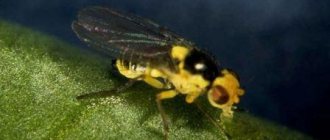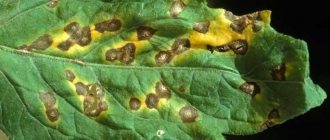Heat-loving pests such as mole crickets prefer greenhouse space most of all, since the soil in it warms up much earlier, the soil, as a rule, is better fertilized, loosened and cools later in the fall. Therefore, those garden and vegetable garden owners who have their own greenhouse are most often susceptible to attacks by mole crickets, which try to concentrate in this space.
In this article we will talk about some ways to combat mole crickets in a greenhouse that bring at least some effect. However, we must remember that the path ahead is quite difficult and not every gardener has the strength and patience to complete the task. Therefore, if a goal is set, you need to strive for it; there is no place for laziness and confusion in this matter.
Medvedka: description and damage caused
Mole crickets are large burrowing insects that form a separate family. They are 5-9 cm long and live in burrows they dig. The appearance of the pest is very characteristic; it is difficult to confuse it with any other insect.
Medvedka
The fight against mole crickets on the site is, first of all, a strategic fight. Leading a secretive lifestyle, the insect always finds options on how to survive in the conditions of certain countermeasures, therefore, in order to defeat this pest, just one method of exterminating it is not enough; it is necessary to use several.
The insect's forelimbs are seriously modified and adapted for digging. The chest shell is thick and very durable. In case of danger, the insect's head is completely retracted under it.
The abdomen is long, approximately 2-3 times larger than the cephalothorax, however, it is practically not protected by a chitinous layer. The body color of a mole cricket is almost always the same – it is dark brown on top and light brown or olive underneath.
A mole cricket protecting its clutch
The insect is a pest of many crops. All tuberous, root, berry and fruit crops are included in the list of the mole cricket’s diet. If there are no root crops, the pest moves on to rhizomes and bulbs.
In particularly serious cases, it even damages the root system of not only fruit trees, but also non-fruit trees.
Mole cricket larva
Signs of the appearance of a mole cricket on the site are its passages, burrows and loud evening chirping, reminiscent of the sounds made by crickets. Which, however, is not surprising, the families of Medvedkov and Real Crickets are very close relatives.
Mole cricket moves after precipitation
Preventive measures
Preventive measures will help not only protect the garden from the mole cricket, but also exterminate it. There are several effective preventive measures:
- Deep digging of the site. In autumn, it is necessary to dig the soil to a greater depth. This should be done only after the cold weather sets in, otherwise the insect will not die, but will have time to burrow into the ground again and overwinter quite comfortably.
- Try, if possible, to avoid fertilizing the soil with fresh manure, as it attracts mole crickets to the area. You can use chicken manure instead. You should also take into account that, along with fresh manure, you can also bring mole crickets to your site.
- Mulching. The pest lives and reproduces only in warm soil, so tomatoes can be protected by mulching with sawdust, straw or pine needles. Under a thick layer of mulch, the earth will not heat up, and therefore the area will become unattractive to the pest. In addition, the smell of pine needles can scare him away.
In order to protect your garden from the invasion of mole crickets from a neighboring plot, you can make a metal fence, which is buried 0.5–0.6 meters into the ground.
Application of chemistry
Sealing mole cricket burrows with cotton wool
The chemical industry produces a fairly large number of drugs used to kill mole crickets.
Almost all of them are broad-spectrum insecticides that can also destroy the following species:
- larvae of May beetles and bronze beetles
- wireworm larvae and adults
- black garden ants (breeding aphids and mealybugs)
A description of the drugs and the features of their use is given in the table:
Any of the listed drugs (except Boverin) can be used in a mixture with edible bait - oatmeal, buckwheat or pearl barley porridge. Sunflower oil is also added to the bait. In the evening, the resulting mixture is laid out near the bear's burrows in the amount of 10-15 g per hole.
In addition, to combat mole crickets, acetylene is used, which is poisonous for the insect. To do this, 5 g of calcium carbide is placed in each hole and all holes are sealed with cotton wool or soft cloth, covered with earth on top.
When the substance reacts with water (in the form of rain or irrigation water), it decomposes into acetylene, which fills the mole cricket's burrows and passages. The gas quickly kills the insect.
Kerosene can also be used against mole crickets. However, this comes with some problems: due to the relatively high toxicity of the drug, it is not recommended for use in large quantities. You can fill no more than 1-2 holes on the site with kerosene; Up to 50 ml of substance is consumed for each hole.
What kind of pest is this
The mole cricket, or cabbage weed, is a large brown-brown insect of the order Orthoptera, reaching five centimeters in length. It has strong jaws, a pair of wide burrowing limbs and transparent wings curled into thin tubes. The insect prefers warm and moist soils, so it often penetrates into greenhouses, where ideal conditions are created for its life and reproduction. Typically feeds on plant parts, small insects and worms
The pest is extremely prolific - the female lays up to 400 large eggs in spherical nests, arranged at a depth of 10-15 cm. The larva is similar to an adult and is smaller in size, as well as lighter in body color. The growth period of young animals is two years.
Repellent methods
Folk method of struggle
The mole cricket, like all insects, is able to distinguish odors well. There are odors that are both pleasant and unpleasant for insects. The list of the latter is quite extensive - it includes both the smells of certain substances and the smells of certain plants.
Therefore, to avoid the appearance of an uninvited insect, it is recommended to use the following methods:
1 In the spaces between the rows, as well as along the perimeter of the site, you can plant plants that are “unpleasant”
- calendula
- marigold
- chrysanthemums
2 To protect potato crops from insects, after flowering, you need to place branches of coniferous plants between the rows:
- fir
- ate
- pine trees
Mulching with pine needles between rows
3 Make stakes up to 40 cm long from freshly cut aspen or alder branches (at least 30 mm thick). They must be buried at a distance of at least 25 cm at a distance of no more than 1.5 m from each other. In this case, the bark should remain on the stakes. The stakes should be renewed as they dry out.
4 It is recommended to fill the mole cricket’s passages with a solution of onion peels
5 When planting plants, it is recommended to add a peeled clove of garlic under each plant.
6 Instead of garlic, you can put small fish (not salted, of course) under each plant.
7 Greenhouses should be fenced around the perimeter with furrows 5-10 cm deep, into which pour naphthalene or sand moistened with kerosene
8 For root plants (beets, carrots, parsley, etc.), it is recommended that the first watering be done with a solution of iodine in water (10 drops of iodine are dissolved in 5 liters of water)
How to get rid of mole crickets forever using ammonia
The smell of ammonia repels cabbage grass. Ammonia (10% ammonia, 3-4 tsp) is diluted in 10 liters of water. In order not to harm the plants, this concentration will be sufficient. Young seedlings are watered with the mixture at the rate of 0.5 liters per plant. The smell of the drug disappears quickly, so this procedure is repeated once a week. If the leaves on the plants turn yellow, stop watering with the product. In order not to harm the seedlings, pieces of fabric are soaked in ammonia and laid out between the plants.
Biological methods
The mole cricket has many natural enemies. First of all, these are birds. The greatest damage to the population is caused by rooks, crows, starlings and even ordinary chickens.
Hoopoe catching a mole cricket
It is recommended to let the latter out into the garden from time to time. Naturally, this needs to be done at a time when the chickens themselves cannot harm the crops; for example, before the beginning of periods of active growth of young plants, fruiting, harvesting, etc. Chickens are able to perfectly find mole crickets and their larvae and destroy them.
In addition, hedgehogs, lizards, shrews, moles and ants are involved in the destruction of mole crickets. Attracting, for example, a hedgehog to your garden is very simple - just place a saucer of milk in the garden every evening.
With birds, everything is also relatively simple - birdhouses or nest boxes on the site will significantly improve the situation with any harmful insects, including mole crickets.
There is also a highly specialized enemy of the mole cricket – the Larra anathema wasp. This type of wasp lays eggs exclusively in mole crickets, where their development occurs. After the larva matures, it leaves the host, who soon dies.
Larra anathema wasp, a natural enemy of the mole cricket
This insect does not pose any harm to humans, plants and other inhabitants of the garden, therefore, if you encounter this wasp, there is no need to destroy it. The wasp is quite widespread in the south of the European part of Russia, in the Krasnodar Territory, as well as in Ukraine, Moldova, and Georgia.
If the issue of counteracting mole crickets is very pressing, you can also try to use wasps to combat them. Legumes are used to attract wasps. larra” is best attracted to a plant called “partridge pea”.
Prevention of occurrence
A typical insect light trap used to control mole crickets
To protect the area from the appearance of unwanted guests in the form of mole crickets, a number of measures should be taken. Most of them are in the nature of general recommendations carried out when counteracting various pests.
Such measures include:
1 Planting the repellent plants described earlier on the site
2 Digging of areas along the perimeter with furrows with naphthalene or special means Medvetsid
3 Systematic inspection of all types of soil and fertilizers brought to the site (manure, humus, black soil, sand, etc.) to search for mole crickets, their eggs and larvae. Approximately a third of the cases of pest penetration into plots occur with imported soil material
4 Regular weeding and loosening of the soil. Weed removal
5 During the mole cricket’s flight (mid-to-late May), use specialized light traps that are suspended above containers (you can use a regular basin) with a water-kerosene composition. Insects, flying towards the light, stumble upon a trap and fall into a basin, where a layer of kerosene located above the water envelops their bodies, causing suffocation and death
6 Since the mole cricket lives exclusively in acidic soils, it is recommended to carry out annual deacidification of the site by adding dolomite flour or lime to the soil.
At the same time, it must be said right away that some methods of preventing the appearance of pests are not applicable to mole crickets. For example, burying metal mesh around the perimeter of the site, which is very effective against moles, will not have any effect on mole crickets.
Firstly, mole crickets are somewhat smaller than moles, and secondly, unlike moles, they can move both on the ground and in the air.
Meet the Beetle
What a mole cricket is is known to gardeners who are mercilessly fighting this pest. A large insect with a strange appearance. It is called a masterpiece of evolution. The garden mole cricket lives in the ground, flies - rises into the air to a height of 5 m, swims - overcomes puddles, and escapes from flooding.
Three pairs of limbs perform different functions. The front ones are designed for digging trenches in the ground. With claws at the ends, more like the paws of a mole. The middle limbs provide the insect with fast, nimble movement. Because of this property, the mole cricket is called a top. The hind limbs are springy, allowing the beetle to jump high. To all this add a body length of about 8 cm, long mustache, tail, wings - you get a real monster.
Despite its terrifying appearance, the mole cricket does not bite and does not threaten human life. The sabotage lies in her life activity.











